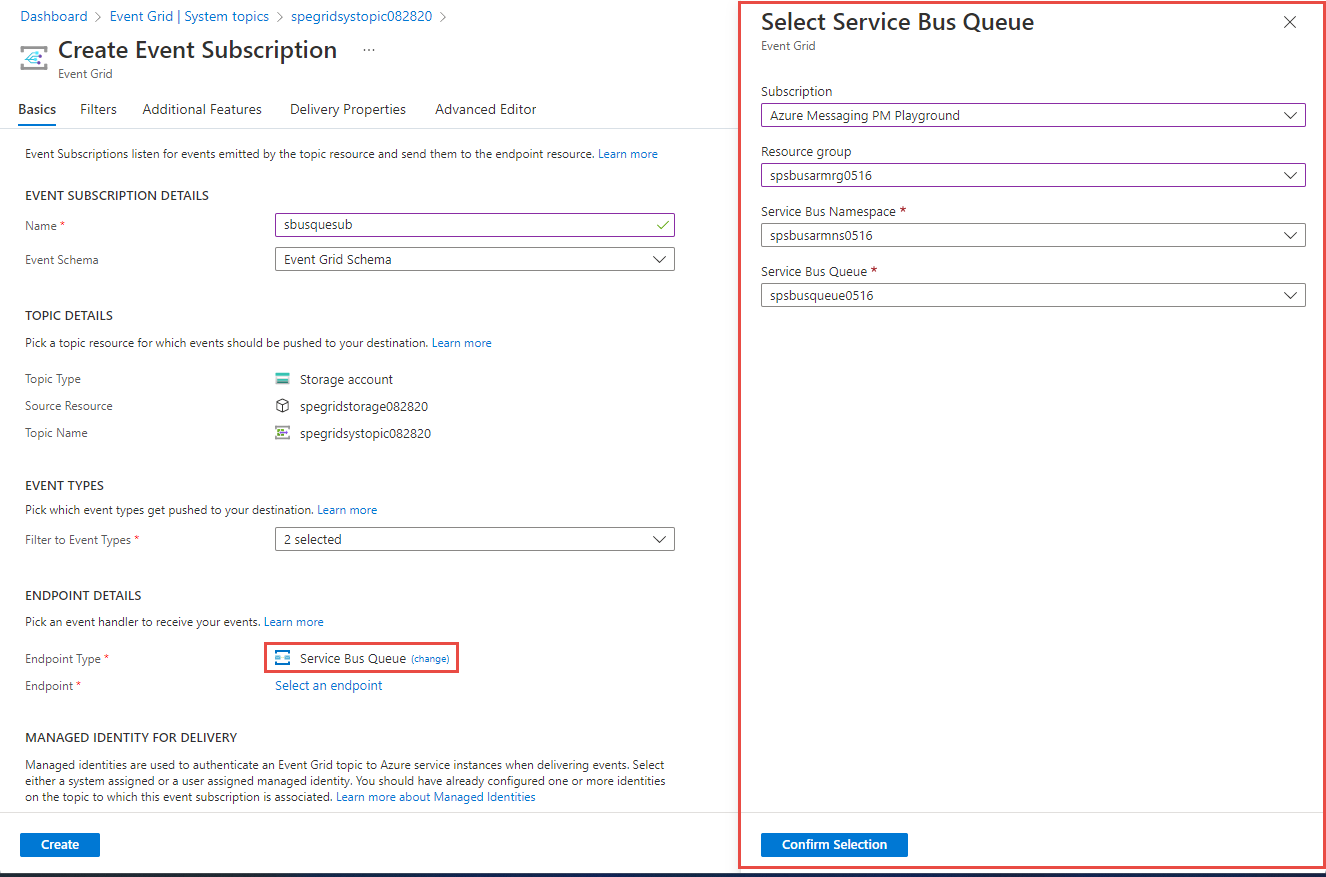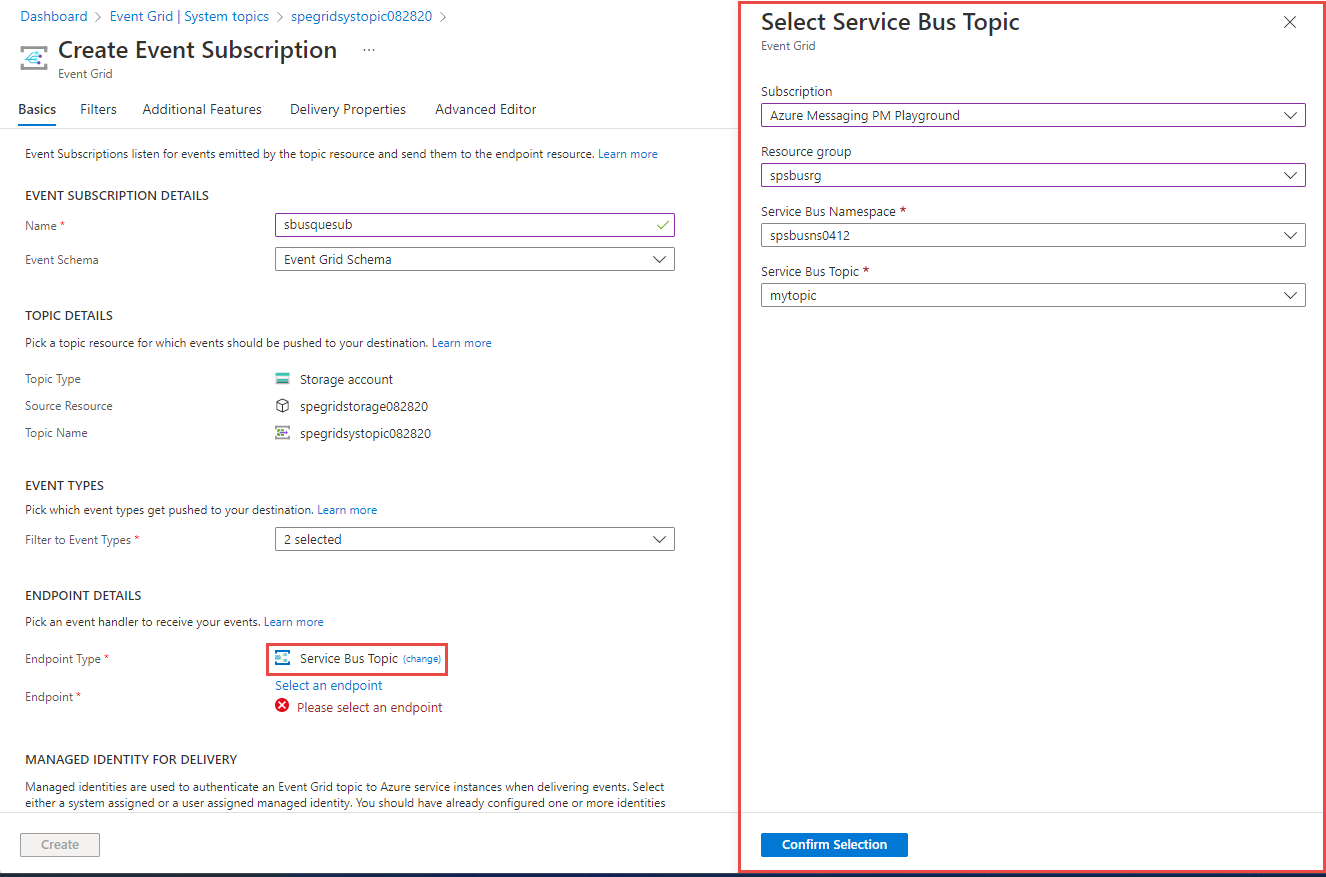Service Bus queues and topics as event handlers for Azure Event Grid events
An event handler receives events from an event source via Event Grid, and processes those events. You can use instances of a few Azure services to handle events and Azure Service Bus is one of them. This article shows you how to use a Service Bus queue or topic as a handler for events from Event Grid.
Service Bus queues
You can route events in Event Grid directly to Service Bus queues for use in buffering or command and control scenarios in enterprise applications.
Use Azure portal
In the Azure portal, while creating an event subscription, select Service Bus Queue as the endpoint type and then click select an endpoint to choose a Service Bus queue.
Note
If you are using session enabled queue/topic subscription as the destination, you need to set the session property on the event using Delivery Property with the header name 'SessionId'.
Use Azure CLI
Use the az eventgrid event-subscription create command with --endpoint-type set to servicebusqueue and --endpoint set to /subscriptions/{AZURE SUBSCRIPTION}/resourceGroups/<RESOURCE GROUP NAME>/providers/Microsoft.ServiceBus/namespaces/<NAMESPACE NAME>/queues/<QUEUE NAME>. Here's an example:
az eventgrid event-subscription create \
--name <my-event-subscription> \
--source-resource-id /subscriptions/{SubID}/resourceGroups/{RG}/providers/Microsoft.EventGrid/topics/topic1 \
--endpoint-type servicebusqueue \
--endpoint /subscriptions/{SubID}/resourceGroups/TestRG/providers/Microsoft.ServiceBus/namespaces/ns1/queues/queue1
You can also use the az eventgrid topic event-subscription command for custom topics, the az eventgrid system-topic event-subscription command for system topics, and the az eventgrid partner topic event-subscription create command for partner topics.
Use Azure PowerShell
Use the New-AzEventGridSubscription command with -EndpointType set to servicebusqueue and -Endpoint set to /subscriptions/{AZURE SUBSCRIPTION}/resourceGroups/<RESOURCE GROUP NAME>/providers/Microsoft.ServiceBus/namespaces/<NAMESPACE NAME>/queues/<QUEUE NAME>. Here's an example:
New-AzEventGridSubscription -ResourceGroup MyResourceGroup `
-TopicName Topic1 `
-EndpointType servicebusqueue `
-Endpoint /subscriptions/{SubID}/resourceGroups/TestRG/providers/Microsoft.ServiceBus/namespaces/ns1/queues/queue1 `
-EventSubscriptionName EventSubscription1
You can also use the New-AzEventGridSystemTopicEventSubscription command for system topics, and the New-AzEventGridPartnerTopicEventSubscription command for partner topics.
Service Bus topics
You can route events in Event Grid directly to Service Bus topics for command and control messaging scenarios.
Use Azure portal
In the Azure portal, while creating an event subscription, select Service Bus Topic as the endpoint type and then click select an endpoint to choose a Service Bus topic.
Use Azure CLI
Use the az eventgrid event-subscription create command with --endpoint-type set to servicebustopic and --endpoint set to /subscriptions/{AZURE SUBSCRIPTION}/resourceGroups/<RESOURCE GROUP NAME>/providers/Microsoft.ServiceBus/namespaces/<NAMESPACE NAME>/topics/<TOPIC NAME>. Here's an example:
az eventgrid event-subscription create \
--name <my-event-subscription> \
--source-resource-id /subscriptions/{SubID}/resourceGroups/{RG}/providers/Microsoft.EventGrid/topics/topic1 \
--endpoint-type servicebustopic \
--endpoint /subscriptions/{SubID}/resourceGroups/TestRG/providers/Microsoft.ServiceBus/namespaces/ns1/topics/topic1
You can also use the az eventgrid topic event-subscription command for custom topics, the az eventgrid system-topic event-subscription command for system topics, and the az eventgrid partner topic event-subscription create command for partner topics.
Use Azure PowerShell
Use the New-AzEventGridSubscription command with -EndpointType set to servicebustopic and -Endpoint set to /subscriptions/{AZURE SUBSCRIPTION}/resourceGroups/<RESOURCE GROUP NAME>/providers/Microsoft.ServiceBus/namespaces/<NAMESPACE NAME>/topics/<TOPIC NAME>. Here's an example:
New-AzEventGridSubscription -ResourceGroup MyResourceGroup `
-TopicName Topic1 `
-EndpointType servicebustopic `
-Endpoint /subscriptions/{SubID}/resourceGroups/TestRG/providers/Microsoft.ServiceBus/namespaces/ns1/topics/topic1 `
-EventSubscriptionName EventSubscription1
You can also use the New-AzEventGridSystemTopicEventSubscription command for system topics, and the New-AzEventGridPartnerTopicEventSubscription command for partner topics.
Message headers
These are the properties you receive in the message headers:
| Property name | Description |
|---|---|
| aeg-subscription-name | Name of the event subscription. |
| aeg-delivery-count | Number of attempts made for the event. |
| aeg-event-type | Type of the event. It can be one of the following values:
|
| aeg-metadata-version | Metadata version of the event. For Event Grid event schema, this property represents the metadata version and for cloud event schema, it represents the spec version. |
| aeg-data-version | Data version of the event. For Event Grid event schema, this property represents the data version and for cloud event schema, it doesn't apply. |
| aeg-output-event-id | ID of the Event Grid event. |
When you send an event to a Service Bus queue or topic as a brokered message, the messageid of the brokered message is an internal system ID.
The internal system ID for the message is maintained across redelivery of the event so that you can avoid duplicate deliveries by turning on duplicate detection on the service bus entity. We recommend that you enable duration of the duplicate detection on the Service Bus entity to be either the time-to-live (TTL) of the event or max retry duration, whichever is longer.
Delivery properties
Event subscriptions allow you to set up HTTP headers that are included in delivered events. This capability allows you to set custom headers that the destination requires. You can set custom headers on the events that are delivered to Azure Service Bus queues and topics.
Azure Service Bus supports the use of following message properties when sending single messages.
| Header name | Header type |
|---|---|
MessageId |
Dynamic |
PartitionKey |
Static or dynamic |
SessionId |
Static or dynamic |
CorrelationId |
Static or dynamic |
Label |
Static or dynamic |
ReplyTo |
Static or dynamic |
ReplyToSessionId |
Static or dynamic |
To |
Static or dynamic |
ViaPartitionKey |
Static or dynamic |
Note
- The default value of
MessageIdis the internal ID of the Event Grid event. You can override it. For example,data.field. - You can only set either
SessionIdorMessageId.
For more information, see Custom delivery properties.
REST examples (for PUT)
Service Bus queue
{
"properties":
{
"destination":
{
"endpointType": "ServiceBusQueue",
"properties":
{
"resourceId": "/subscriptions/<AZURE SUBSCRIPTION ID>/resourceGroups/<RESOURCE GROUP NAME>/providers/Microsoft.ServiceBus/namespaces/<SERVICE BUS NAMESPACE NAME>/queues/<SERVICE BUS QUEUE NAME>"
}
},
"eventDeliverySchema": "EventGridSchema"
}
}
Service Bus queue - delivery with managed identity
{
"properties": {
"deliveryWithResourceIdentity":
{
"identity":
{
"type": "SystemAssigned"
},
"destination":
{
"endpointType": "ServiceBusQueue",
"properties":
{
"resourceId": "/subscriptions/<AZURE SUBSCRIPTION ID>/resourceGroups/<RESOURCE GROUP NAME>/providers/Microsoft.ServiceBus/namespaces/<SERVICE BUS NAMESPACE NAME>/queues/<SERVICE BUS QUEUE NAME>"
}
}
},
"eventDeliverySchema": "EventGridSchema"
}
}
Service Bus topic
{
"properties":
{
"destination":
{
"endpointType": "ServiceBusTopic",
"properties":
{
"resourceId": "/subscriptions/<AZURE SUBSCRIPTION ID>/resourceGroups/<RESOURCE GROUP NAME>/providers/Microsoft.ServiceBus/namespaces/<SERVICE BUS NAMESPACE NAME>/topics/<SERVICE BUS TOPIC NAME>"
}
},
"eventDeliverySchema": "EventGridSchema"
}
}
Service Bus topic - delivery with managed identity
{
"properties":
{
"deliveryWithResourceIdentity":
{
"identity":
{
"type": "SystemAssigned"
},
"destination":
{
"endpointType": "ServiceBusTopic",
"properties":
{
"resourceId": "/subscriptions/<AZURE SUBSCRIPTION ID>/resourceGroups/<RESOURCE GROUP NAME>/providers/Microsoft.ServiceBus/namespaces/<SERVICE BUS NAMESPACE NAME>/topics/<SERVICE BUS TOPIC NAME>"
}
}
},
"eventDeliverySchema": "EventGridSchema"
}
}
Note
When a failover occurs for a Service Bus namespace that's Geo-Disaster Recovery enabled, the secondary namespace doesn't emit events to Event Grid. You need to manually add the Event Grid subscription for the secondary namespace.
Next steps
See the Event handlers article for a list of supported event handlers.

